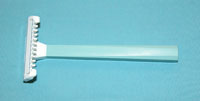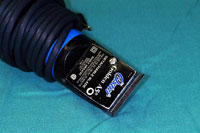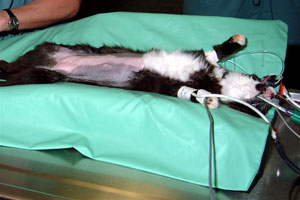Hair removal
The patient’s hair must be removed from the surgical site and surrounding area.
- hair contains large numbers of microorganisms
- hair prevents proper skin cleaning
- hair causes a foreign body reaction if gets into the tissues below the skin
There are several ways of removing the hair, but all methods cause some skin trauma and inflammation.

Razor
- leaves minimal stubble
- causes multiple lacerations and skin erosions
- associated with a 10-fold increase in surgical infections
- should NOT be used
Depilatories
- atraumatic
- do not work well on animals
- expensive
- frequent skin reactions, especially in cats

Clipping
- efficient
- relatively atraumatic
- associated with lowest infection rates
Procedure for Clipping
- Hair should NOT be clipped before anesthetic induction.
- clipping is performed outside the surgical suite
WHY NOT?
- clip at least 15 cm (6 in) around proposed incision (25 cm in large animals)
- if access to paw or hoof is not needed, cover rather than clip them
- these areas have higher resident bacterial populations
- are difficult to clip without significant skin trauma
- are difficult to effectively clean
- hair is vacuumed
- preliminary skin prep is performed before moving patient into surgery suite
Expressing the Bladder
- Animals should be walked to void before anesthesia is induced.
- minimizes messes and cleaning
- the bladder is expressed under anesthesia to make the surgery easier
- easier to work on the caudal abdomen (eg. uterine body)
- minimizes voiding during surgery and subsequent wetting of the area
- Technique
- palpate bladder with one or both hands depending on size of animal
- apply firm steady pressure to bladder
- continue to apply pressure until bladder is empty (can be difficult to restart)
Transporting and positioning

- patients should be moved on a trolley to the surgical site
- circulating water heating pad* placed between the patient and table
- minimize intra-operative hypothermia*
- Do NOT use electric heating pads (erratic temperature control can result in severe burns)
- other techniques to minimize heat loss include:
- Warming intravenous fluids
- Baer huggers
- Position patient so have complete access to surgical site
-
- Secure with ropes, adhesive tape or vacuum‑activated positioning bags *
- Surgical site can then be prepped (scrub and final prep)
Antiseptics
- prevent microorganism’s growth or action on living tissue by killing them or inhibiting their activity
- effectiveness is measured by:
- Immediate efficacy* (amount of skin microorganisms mechanically removed or inactivated within 3 minutes of applying).
- Persistent antimicrobial effectiveness* (ability to prevent recolonization of skin up to 6 hours after applied).
- Residual action* (cummulative antimicrobial effectiveness after used for at least 5 days)
Details on commonly used antiseptics
Mechanism of action: Increases bacterial wall permeability, precipitates cell contents
Required contact time: Maximal efficacy if > 2 minutes contact time
Spectrum: Broad spectrum (NOT non-enveloped viruses, spores or mycobacterium)
Bacteriocidal Immediate action*: Rapid and very good
Bacteriocidal Persistent action*: Excellent
Bacteriocidal Residual action*: Excellent (Binds to stratum corneum*)
Toxicity: No systemic toxicity Occasional skin reaction Ototoxic (middle, inner) Neurotoxic (direct contact) Corneal toxicity if >2%
Other: Remains active with organic material
Mechanism of action: active agent is iodine Inhibits protein synthesis
Required contact time: Maximal efficacy if > 2 minutes contact time
Spectrum: Broad spectrum (spores only if > 15 minutes contact)
Bacteriocidal Immediate action*: Rapid and very good
Bacteriocidal Persistent action*: Good
Bacteriocidal Residual action*: None
Toxicity: Acute contact dermatitis (50% of small animals) Thyroid dysfunction? Can absorb toxic amounts from mucus membranes, peritoneal surfaces and large open wounds
Other: Inactivated by organic material (eg. blood, pus) More effective if diluted Economical
Mechanism of action: Damages lipid in cell wall, precipitates proteins, inhibits mitosis
Required contact time: (before alcohol evaporates)
Spectrum: Broad spectrum (NOT spores)
Bacteriocidal Immediate action*: Very Rapid and excellent
Bacteriocidal Persistent action*: Very Good
Bacteriocidal Residual action*: Some (continued death of damaged organisms)
Toxicity: Nontoxic if intact skin (can dry & irritate skin) Cutaneous absorption in neonates, none adults Tissue necrosis in open wounds
Other: Increases initial kill by chlorhexidine and iodophors, More effective if diluted
Skin preparation
Goal: to make the skin surgically clean
- not possible to sterilize
- approximately 20% of skin bacteria are in deeper skin layers protected from exposure to the antiseptic
- these bacteria will migrate to surface over time and progressively repopulate the area

